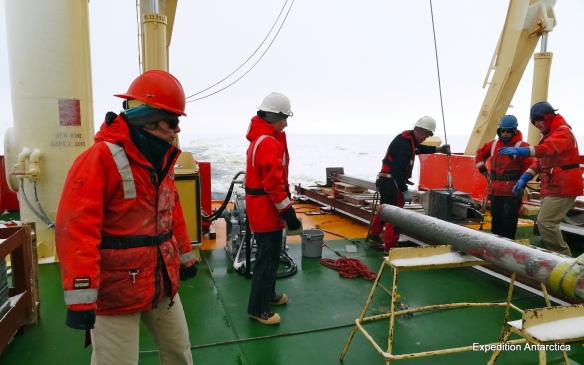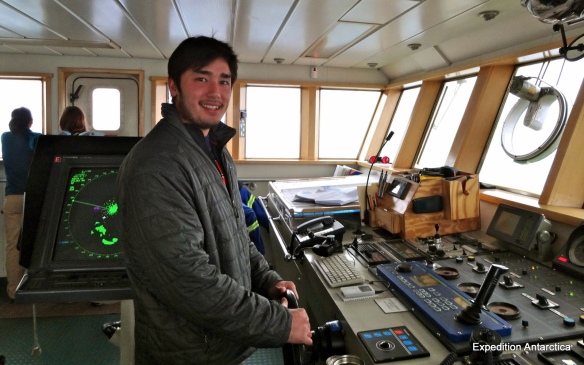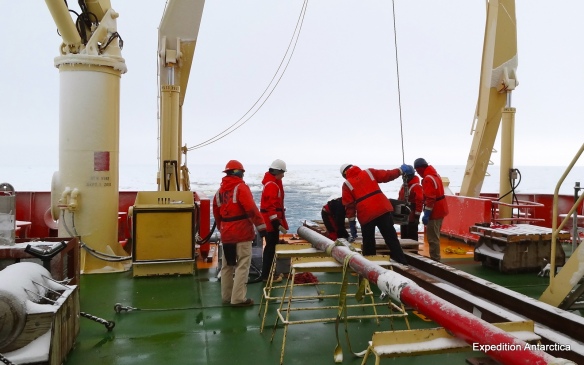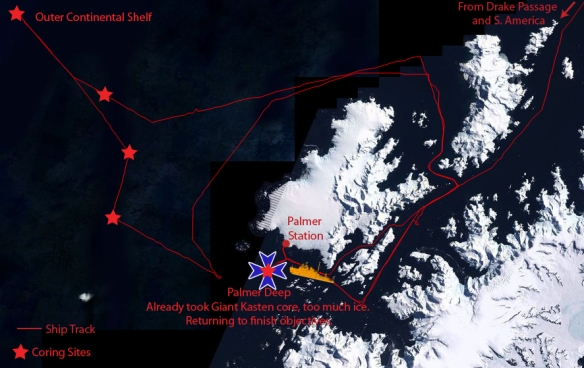Tasha writes:
When you are a geologist, there is no greater happiness than when you are neck deep in the mud of a well-taken core. That’s how I’ve felt for the last couple days. Alex and I have been standing 12-hour watches together from noon to midnight each day. The science party has been working non-stop, as we have few people and a whole ton of work to do.
In total so far, we have taken three jumbo gravity cores, a jumbo kasten core, and three regular sized kasten cores. The gravity core differs from the kasten core in having a liner within the pipe that stays around the sediments until the core is cut open in a core repository like the one we will use at Florida State University (check my last blog to learn about kasten cores). The gravity core is round, not square like the kasten, and can go much deeper into sediments because it is heavily weighted and dropped rapidly to the bottom of the ocean. It blows past the soft upper layer of sediments usually, so we take the kasten core in the same location to get a continuous sediment record.

Amelia and Tasha get ready to inspect a fresh kasten core. Gravity core in the foreground, with till on the outer barrel.
Like the kasten core, there is a trick to taking a great gravity core especially in Antarctica. Here there are layers of sediment, called glacial till. Glacial till comes directly from an ice sheet that is grinding up rocks and sediments then spitting them out from the edge of the ice sheet onto the ocean floor, creating what is called a glacial fan deposit. Glacial till can be very dense sediment and may as well be concrete to a gravity core trying to penetrate into it. If the gravity core penetrates too far into the till, the core barrel will bend as if it has hit a concrete wall.
However, we really want to know where the transition from the glacial till to softer sediments takes place so we can date it. So, to make a long story short, Amelia has her work cut out for her in deciding how long of a core she wants and where to drop the core so that she doesn’t destroy the barrel but still recovers as much sediment as possible. It’s an art, and Amelia has been pretty successful so far.
Why is getting the glacial till so important in some of our cores? Well, our coring sites are currently pretty far away from the edges of the ice sheets and have soft, interglacial (warm climate) sediments being deposited. However, over 13,000 years ago during the Southern Hemisphere Last Glacial Maximum, Antarctic ice sheets were at their largest extent out to the edge of the continental shelf. When an ice sheet sits over an area, the area is scraped clean of sediments. When the edge of the ice sheet is nearby, but not over a site, it deposits glacial till. Lastly, when it has retreated away from an area, the softer sediments begin to be deposited (these tend to have more organic matter and we can use radiocarbon measurements to get sediment ages).
In this region, one of the questions we are asking is: when did the ice sheet begin to retreat back towards the continent? To answer this, we find the layer of the last deposits of glacial till in the area, date the interglacial sediments just above it, and determine when the ice sheet withdrew from that point.
During the course of this trip, we strategically took sediment cores from the outer continental shelf near the maximum extent of the ice sheet, midway out on the shelf, and a few other areas. Some of these cores are meant to capture the transition from glacial till to interglacial sediment and some are used for other questions I will cover in the next blog. For now, time to get some sleep because if we push through this thick ice and somehow make it to Palmer Deep, I’m going to be need to be up soon.




may the ice be ever in your favor.. good luck in the palmer deep
Pingback: 11/7/2013 – Best Cruise Days Yet | Expedition Antarctica